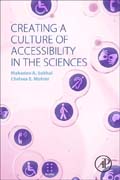
Creating a Culture of Accessibility in the Sciences
Sukhai, Mahadeo A.
Mohler, Chelsea E.
Creating a Culture of Accessibility in the Sciences provides insights and advice on integrating students with disabilities into the STEM fields. Each chapter features research and best practices that are interwoven with experiential narratives. The book is reflective of the diversity of STEM disciplines (life and physical sciences, engineering, and mathematics), and is also reflective of cross-disability perspectives (physical, sensory, learning, mental health, chronic medical and developmental disabilities). It is a useful resource for STEM faculty and university administrators working with students with disabilities, as well as STEM industry professionals interested in accommodating employees with disabilities. Offers a global perspective on making research or work spaces accessible for students with disabilities in the STEM fieldsDiscusses best practices on accommodating and supporting students and demonstrates how these practices can be translated across disciplinesEnhances faculty knowledge of inclusive teaching practices, adaptive equipment, accessibility features, and accommodations in science laboratories, which would enable the safe participation of students with disabilitiesProvides advice for students with disabilities on disclosure and mentoring INDICE: Part I: Students with Disabilities in Laboratory EnvironmentsChapter 1: Landscape of Students with Disabilities in Laboratory and Practical SettingsChapter 2: Barriers Faced by Students with Disabilities in Laboratory and Practical SettingsChapter 3: The Process of DisclosurePart II: The Role of Faculty in Building an Accessible CultureChapter 4: Essential RequirementsChapter 5: Inclusive Teaching PracticesChapter 6: Key Role of Education ProvidersChapter 7: MentorshipChapter 8: Supervision of TraineesPart III: Accessibility in Laboratory and Practical Space Learning EnvironmentsChapter 9: Considerations for Creating Accessible Laboratories and Practical SpacesChapter 10: Adapting Technologies in Laboratories and Practical SpacesChapter 11: Alternative Formats in Science and Technology DisciplinesChapter 12: Accessible Course PlatformsChapter 13: Physical Access in the Laboratory/Practical Space SettingPart IV: AccommodationChapter 14: Thinking About AccommodationChapter 15: Human Accommodation - the Benefits of Laboratory/Technical AssistantsChapter 16: FieldworkChapter 17: Simulation LearningPart V: A Global PerspectiveChapter 18: General Principles of Designing Accessible Learning EnvironmentsChapter 19: Accessibility and STEM - the Global PerspectiveChapter 20: Conclusions
- ISBN: 978-0-12-804037-9
- Editorial: Academic Press
- Encuadernacion: Rústica
- Páginas: 192
- Fecha Publicación: 01/09/2016
- Nº Volúmenes: 1
- Idioma: Inglés
